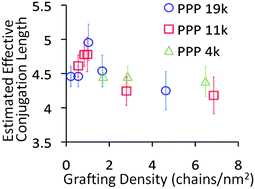Grafting density effects, optoelectrical properties and nano-patterning of poly(para-phenylene) brushes†
Abstract
Well-defined conjugated polymers in confined geometries are challenging to synthesize and characterize, yet they are potentially useful in a broad range of organic optoelectronic devices such as transistors, light emitting diodes, solar cells, sensors, and nanocircuits. Herein we report a systematic study of optoelectrical properties, grafting density effects, and nanopatterning of a model, end-tethered conjugated polymer system. Specifically, poly(para-phenylene) (PPP) brushes of various grafting density are created in situ by aromatizing well-defined, end-tethered poly(1,3-cyclohexadiene) (PCHD) “precursor brushes”. This novel precursor brush approach provides a convenient way to make and systematically control the grafting density of high molecular weight conjugated polymer brushes that would otherwise be insoluble. This allows us to examine how grafting density impacts the effective conjugation length of the conjugated PPP brushes and to adapt the fabrication method to develop spatially patterned conjugated brush systems, which is important for practical applications of conjugated polymer brushes.


 Please wait while we load your content...
Please wait while we load your content...